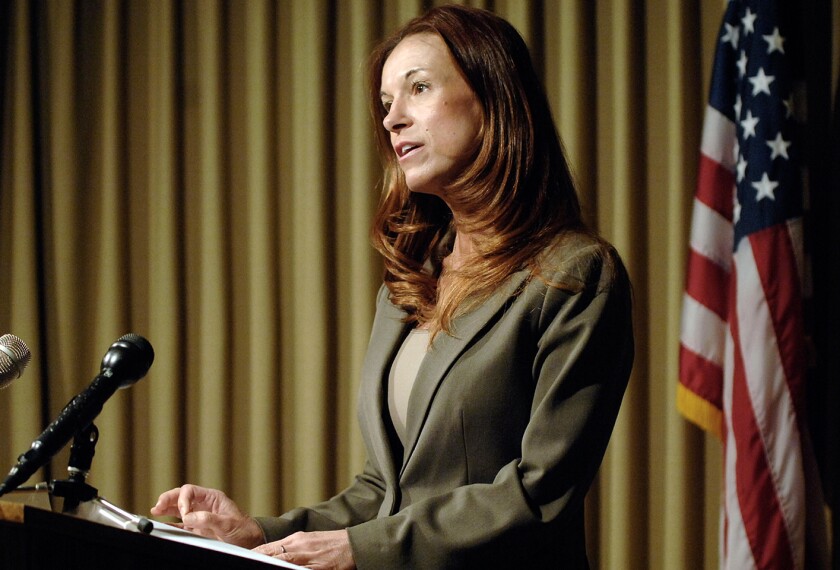President Clinton has ordered federal education officials to help states and districts turn around low-performing schools and to release an annual report card on such efforts.
The president issued an executive order in Owensboro, Ky., last week as part of a two-day tour to highlight what he considers promising education reforms and promote his proposals for greater accountability for school performance. The document directs the Department of Education to compile data on low-performing schools and provide research and assistance to states and districts.
“We’ve now had 20 years of serious effort at educational reform. ... We know what works,” Mr. Clinton said May 3. “I came to Kentucky to show America how a whole state can identify and turn around low-performing schools with high standards and accountability, parental involvement, and investments to help the schools and the students and the teachers meet the standards.”
Mr. Clinton also visited a charter school in St. Paul, Minn.; touted his school construction proposal in Davenport, Iowa; and promoted plans for better teacher training in Columbus, Ohio. In Minnesota, he called on the federal Education Department to issue guidelines to help businesses and religious groups, among other community members, become involved in charter schools.
His executive order directs the secretary of education to:
- Provide technical assistance and research to help states’ and districts’ improvement efforts;
- Make federal education programs more responsive to low-performing schools;
- Submit an annual report that would include emerging trends and effective strategies from those schools, as well as look at the efforts being made to turn the schools around and the resources the schools are receiving; and
- Send federal monitors into as many as 15 states each year to ensure that states are complying with accountability requirements.
The president’s plans for aiding failing schools dovetail with ideas put forward by Vice President Al Gore as part of his campaign to succeed Mr. Clinton. Mr. Gore recently proposed a $500 million accountability plan that would require states and districts to identify and fix failing schools and offer supplemental resources, such as after-school programs, for students in those schools.
Congressional Republicans saw more politics than substance in Mr. Clinton’s high-profile education tour. Rep. Bill Goodling of Pennsylvania, who chairs the House Education and the Workforce Committee, said that while Mr. Clinton’s efforts to praise schools that have shown remarkable achievements were laudable, last week’s appearances were motivated by the president’s desire to promote his favorite initiatives.
“We should be focusing on how to provide maximum leverage for local dollars,” Mr. Goodling said in a written statement. Mr. Clinton, he said, “needs to put the needs of the nation ahead of political considerations.”
Amy Wilkins, a policy analyst for the Education Trust, a nonpartisan, Washington-based advocacy group for disadvantaged children, said she did not expect Mr. Clinton’s executive order to have much effect on overall efforts to raise standards for students in all schools.
“It’s good for what it is, but it’s only a small piece of what needs to be done,” she said. “The problem with the administration’s construction of accountability is that they have it in their head that accountability only means attention to those schools at the bottom.”
Religion, Charter Schools
Last Thursday, the second day of the tour, Mr. Clinton directed Secretary of Education Richard W. Riley to issue guidelines on charter schools so that religious groups and private employers might be more willing to make contributions to and help guide the development of the largely independent public schools. The role of religious groups in such schools has raised questions in some communities and is being played out in court cases. (“Buildings in Hand, Church Leaders Float Charter Ideas,” Feb. 10, 1999.)
“While charter schools have to be nonsectarian, there is a role, a positive role, that faith-based groups can play,” Mr. Clinton said. “My goal is to get more money and more people involved in the charter school movement, to break down the walls of resistance among all the educators to it, and to get community people more aware of it.”
Jeanne Allen, the president of the Center for Education Reform, a Washington group that advocates charter schools and other forms of school choice, said she was happy to see the president bring attention to charters and point out that some state laws need strengthening. But she questioned the need for federal guidelines, given that charters are designed to be autonomous.
“Here was a perfect opportunity for a rhetorical, bully-pulpit speech supporting charter schools, but somehow the regulators got a hold of his remarks,” Ms. Allen said. “For the secretary to issue guidelines on something they are not directly involved in raises a red flag.”
Earlier this year, the department reissued a 1996 guide summing up existing laws on religion in charter schools.
President Clinton renewed calls for more charter schools and more federal funding while visiting City Academy in St. Paul, the nation’s first charter school, which opened in 1992. Several times during his speech there, he pointed out that City Academy was still the lone charter school when he took office in 1993, and that now there are nearly 1,700 across the country.
His longtime goal has been to have a total of 3,000 charter schools open by the time he leaves office next January.




